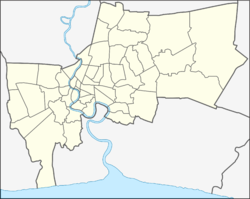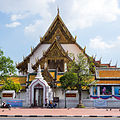Top Qs
Timeline
Chat
Perspective
Wat Suthat
Buddhist temple in Bangkok, Thailand From Wikipedia, the free encyclopedia
Remove ads
Wat Suthat Thepwararam (Thai: วัดสุทัศนเทพวราราม, Thai pronunciation: [wát su.tʰát tʰêːp.pʰá.wáʔ.raː.raːm]) is a Buddhist temple in Bangkok, Thailand. It is a royal temple of the first grade, one of ten such temples in Bangkok (23 in Thailand). Construction was begun by King Rama I in 1807. In the beginning, it was initially called "Wat Maha Sutthawat" (วัดมหาสุทธาวาส) and was located in a combretum grove. Further construction and decorations were carried out by King Rama II who helped carve the wooden doors, but the temple was not completed until the reign of King Rama III in 1847 or 1848. This temple contains the Buddha image Phra Sri Sakyamuni (Thai: พระศรีศากยมุนี; RTGS: Phra Si Sakkayamuni) which have been moved from Sukhothai Province. At the lower terrace of the base, there are 28 Chinese pagodas which symbolize the 28 Buddhas born on this earth. Wat Suthat also contains Phra Buddha Trilokachet (Thai: พระพุทธไตรโลกเชษฐ์; RTGS: Phra Phuttha Trai Lokkachet) in the ubosot (ordination hall) and Phra Buddha Setthamuni (Thai: พระพุทธเศรษฐมุนี; RTGS: Phra Phuttha Setthamuni) in the sala kan parian (meeting hall).
This article relies largely or entirely on a single source. (January 2021) |
In 2005, the temple was submitted to UNESCO for consideration as a future World Heritage Site.
Remove ads
Preta of Wat Suthat

The temple dates back to the beginning of the Rattanakosin Kingdom. At that time, it was said that a preta (Thai: เปรต, pret), a kind of undead being in Buddhist and Siamese belief, often depicted as a tall, thin, hungry ghost with a terrifying howling cry, would appear in front of the temple at night. One mural inside the ordination hall also depicts a preta lying down to receive water from monks. This gave rise to the saying "Pret Wat Suthat" (Thai: เปรตวัดสุทัศน์), often paired with "Raeng Wat Saket" (Thai: แร้งวัดสระเกศ lit. 'vultures of Wat Saket'). In front of the temple stands the Sao Chingcha, or Giant Swing, a towering Hindu-style structure.
Remove ads
Gallery
- Phra Si Sakyamuni is enshrined in the vihara, also known for its exquisite murals.
- Phra Buddha Trilokachet
- Vihara
- Interior of the vihara
- Phra ubosot or Ordination hall
- Interior of the Phra ubosot
- Wat Suthat (left) with Giant Swing (right)
See also
- List of Buddhist temples in Thailand
- Devasathan Hindu temple nearby
References
External links
Wikiwand - on
Seamless Wikipedia browsing. On steroids.
Remove ads











